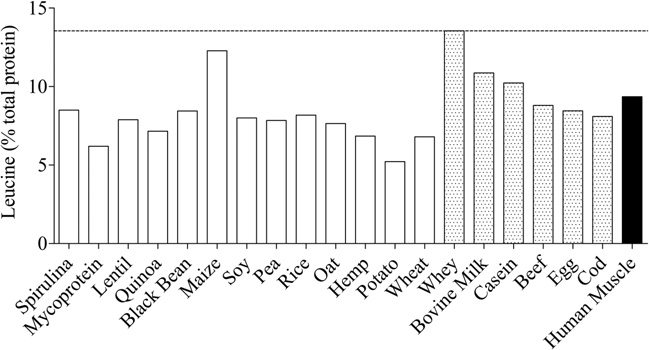Kenny Croxdale
Level 7 Valued Member
At the bottom is the Cliff Notes. Let me add to that.
1) The amount of quality protein consumed per meal is important; not just the amount per day. That because a certain amount of Leucine is necessary to trigger the muscle building, anabolic effect.
Research (Dr Donald Layman) found that the majority of Americans only have one meal a day (Dinner) that provide them enough protein/Leucine to trigger the anabolic effect.
Thus, one of the reasons people lose muscle as they age is that they are starving muscle; not consuming enough protein/Leucine per meal to maintain muscle mass, let alone increase it.
2) The minimal amount of Leucine necessary is age dependent. Younger individuals in their 20's need approximately 2.5 grams of Leucine. Older individuals need over 3.0 grams of Leucine to elicit the same anabolic effect.
3) Refractory Period
It's what I term the "Sponge Effect". Muscle Protein Synthesis is optimized when, metaphorically speaking, muscle is like a dry sponge; it is more receptive to Leucine, it soaks up Luecine that promotes the anabolic effect.
This sponge like effect occurs when the "Muscle Sponge" dries out. That occurs when meals are spaced out every 4 - 6 hours.
The exception to the rule appears to be that Leucine or BCAA triggers a bump in mTOR when taken an hour and a half after a meal and before the next meal.
4) Higher Leucine Levels in Ketosis
Leucine is a Ketogenic Amino Acid.
It cannot be cannot converted to glucose. It can only be converted to ketones.
Research, Dr Volek and Dr Stephen Phinney, M.D, PhD found Leucine Levels remain elevated when on a Ketogenic Diet.
The body realizes it has a plethora of ketones from fat; it doesn't need to utilize Leucine for ketones. It realized to survive that it needs to maintain muscle mass, which is driven in part by Leucine.
5) Glycogenic Amino's
Some glucose is required by the body on a Keto Diet. If needed it is produced from what very few carbohydrates are consumed on a Ketogenic Diet.
If it needs more glucose, it is produced from Glycolytic Amino's and Amino's that are both, Glycolytic and Ketogenic, that can be converted to Glycogen or Ketones, dependent on need.
Glucose is also derived from glycerol, the backbone of Triglycerides.
6) Vegan Protein
Vegan Proteins are sub par. To obtain enough Leucine, you need to substantially increase the amount of Vegan Protein in your diet.
You need to consume around 29 gram of quality protein (meat/dairy) to obtain the minimum of Leucine. That amounts to having a job where you make the minimum amount of money to pay your bills; you are living pay check to pay check, only surviving. F... that.
Vegan's need to consume around 40 gram of vegetable protein to obtain the same minimum of Leucine of those consuming 29 gram of quality protein (meats/dairy).
With that said, some Vegan Protein have higher Leucine content. Adding a quality Vegan Protein Powder Drink to a meal (Pea, Soy, Rice) is one solution. Chart below.

7) The Exception to The Rule
intermittent Fasting is one of the exceptions to the rule. The body primarily utilizes ketones during Fasting. In doing so, it preserves muscle mass (higher Leucine levels are maintained) while increasing lypolysis (fat burning).
8) Low Deficit Calorie Carbohydrate Meals
Research shows that Low Deficit Carbohydrate Meals are catabolic; a greater loss in muscle mass occurs compared to Fasting, where muscle mass is preserved. Fasting Research show the muscle mass is preserved up to 72 hours. After that, catabolism of muscle mass begin.
1) Since the diet is primarily composed of carbohydrates in a Low Deficit Carbohydrate Diet; you are Glucose Dependent.
2) It is easier to break down muscle (gluconeogenesis) to glucose than glycerol in Low Deficit Calorie Carbohydrate Diet than from triglycerides; which make sense. Why work any harder than you have to?
Researchers Point to the Optimal Protein Dose, Timing & Distribution to Maximize Muscle
Cliff Notes Summary
1) The amount of quality protein consumed per meal is important; not just the amount per day. That because a certain amount of Leucine is necessary to trigger the muscle building, anabolic effect.
Research (Dr Donald Layman) found that the majority of Americans only have one meal a day (Dinner) that provide them enough protein/Leucine to trigger the anabolic effect.
Thus, one of the reasons people lose muscle as they age is that they are starving muscle; not consuming enough protein/Leucine per meal to maintain muscle mass, let alone increase it.
2) The minimal amount of Leucine necessary is age dependent. Younger individuals in their 20's need approximately 2.5 grams of Leucine. Older individuals need over 3.0 grams of Leucine to elicit the same anabolic effect.
3) Refractory Period
It's what I term the "Sponge Effect". Muscle Protein Synthesis is optimized when, metaphorically speaking, muscle is like a dry sponge; it is more receptive to Leucine, it soaks up Luecine that promotes the anabolic effect.
This sponge like effect occurs when the "Muscle Sponge" dries out. That occurs when meals are spaced out every 4 - 6 hours.
The exception to the rule appears to be that Leucine or BCAA triggers a bump in mTOR when taken an hour and a half after a meal and before the next meal.
4) Higher Leucine Levels in Ketosis
Leucine is a Ketogenic Amino Acid.
It cannot be cannot converted to glucose. It can only be converted to ketones.
Research, Dr Volek and Dr Stephen Phinney, M.D, PhD found Leucine Levels remain elevated when on a Ketogenic Diet.
The body realizes it has a plethora of ketones from fat; it doesn't need to utilize Leucine for ketones. It realized to survive that it needs to maintain muscle mass, which is driven in part by Leucine.
5) Glycogenic Amino's
Some glucose is required by the body on a Keto Diet. If needed it is produced from what very few carbohydrates are consumed on a Ketogenic Diet.
If it needs more glucose, it is produced from Glycolytic Amino's and Amino's that are both, Glycolytic and Ketogenic, that can be converted to Glycogen or Ketones, dependent on need.
Glucose is also derived from glycerol, the backbone of Triglycerides.
6) Vegan Protein
Vegan Proteins are sub par. To obtain enough Leucine, you need to substantially increase the amount of Vegan Protein in your diet.
You need to consume around 29 gram of quality protein (meat/dairy) to obtain the minimum of Leucine. That amounts to having a job where you make the minimum amount of money to pay your bills; you are living pay check to pay check, only surviving. F... that.
Vegan's need to consume around 40 gram of vegetable protein to obtain the same minimum of Leucine of those consuming 29 gram of quality protein (meats/dairy).
With that said, some Vegan Protein have higher Leucine content. Adding a quality Vegan Protein Powder Drink to a meal (Pea, Soy, Rice) is one solution. Chart below.

7) The Exception to The Rule
intermittent Fasting is one of the exceptions to the rule. The body primarily utilizes ketones during Fasting. In doing so, it preserves muscle mass (higher Leucine levels are maintained) while increasing lypolysis (fat burning).
8) Low Deficit Calorie Carbohydrate Meals
Research shows that Low Deficit Carbohydrate Meals are catabolic; a greater loss in muscle mass occurs compared to Fasting, where muscle mass is preserved. Fasting Research show the muscle mass is preserved up to 72 hours. After that, catabolism of muscle mass begin.
1) Since the diet is primarily composed of carbohydrates in a Low Deficit Carbohydrate Diet; you are Glucose Dependent.
2) It is easier to break down muscle (gluconeogenesis) to glucose than glycerol in Low Deficit Calorie Carbohydrate Diet than from triglycerides; which make sense. Why work any harder than you have to?
Researchers Point to the Optimal Protein Dose, Timing & Distribution to Maximize Muscle
Cliff Notes Summary
- Muscle protein synthesis is an anabolic response that occurs in response to protein feeding and resistance training. On the protein front, it specifically relates to leucine intake. To maximize the MPS response, ~2.5g of leucine is required. This is known as the “leucine threshold”.
- To maximize the muscle protein synthesis response over the course of a day, it seems that 3–4 evenly spaced meals that surpass the leucine threshold is a prudent strategy.
- A meal containing 0.4 grams of protein per kilogram of bodyweight (g/kg BW) from a high-quality protein source will allow an individual to hit the leucine threshold. For most people this is somewhere between 20–40g.
- The best sources of protein for this purpose are animal proteins (particularly whey protein) due to their high branched-chain amino acid composition. Plant-based protein sources will mean a higher protein intake is needed to hit the required level of leucine.
- When MPS is “spiked” in response to a protein feeding, it will drop back to baseline within 2–3 hours. This drop will occur regardless of whether protein or amino acids continue to be fed and leucine remains high. This is potentially due to high demand of ATP required by cells for MPS (i.e. MPS is an energy-expensive process and the cell will stop MPS to conserve energy).
- MPS is only a proxy measure for muscle hypertrophy, not an exact correlate. Net muscle protein balance (MPS vs. muscle protein breakdown) matters more. And further, there are many other factors than influence actual hypertrophy outside of MPS and MPB.
- Of all the macro nutrients, it seems that timing and distribution (versus simply total daily intake) is most important when it comes to protein. However, there are pragmatic examples of scenarios where we may not theoretically maximize MPS, yet still preserve and/or build plenty of muscle mass. For example, daily intermittent fasting.
Last edited:

